Cat litter box training is the process of teaching your furry friend to relieve themselves in the litter tray. While this shouldn’t be too difficult, sometimes pet parents run into a couple of hiccups along the way.
Here’s a step-by-step guide to make this process less challenging & ensure smooth sailing! We’ve included the necessary supplies to begin your litter training journey, how to clean & maintain the litter box, a few things to consider while training your kitten, and common issues experienced during this process.
What Are the Things You’ll Need to Litter Box Train a Cat?
The things you’ll need to litter train a cat are:
- Litter Box: There are tons of varieties of litter boxes, including covered, uncovered, with tall or short walls. Play around with options & see what your kitty prefers.
Tall walls are better for cats that tend to dig around in their litter or spray when they pee. Short walls are typically a safe bet for younger kittens. - Cat Litter: The litter you choose must absorb urine properly so that your cat doesn’t need to step in wetness. It should also be fine & clumping, which makes cleaning up much easier. While scented litters can eliminate odors, you should avoid strong scents as cats tend to dislike those.
- Scoop: You will definitely need a good slotted scooper to pick up the urine & poop your cat has left in the box!
- Location: Spend a few days scoping out your house to find the best location for the litter box. Try to place it where you’ve noticed your cat going to the bathroom.
- Treats: Like in any training process, yummy rewards are absolutely essential to litter training. You need high-quality treats that you can use sparingly when your cat goes to the bathroom in the tray!
How to Train a Cat to Use a Litter Box?
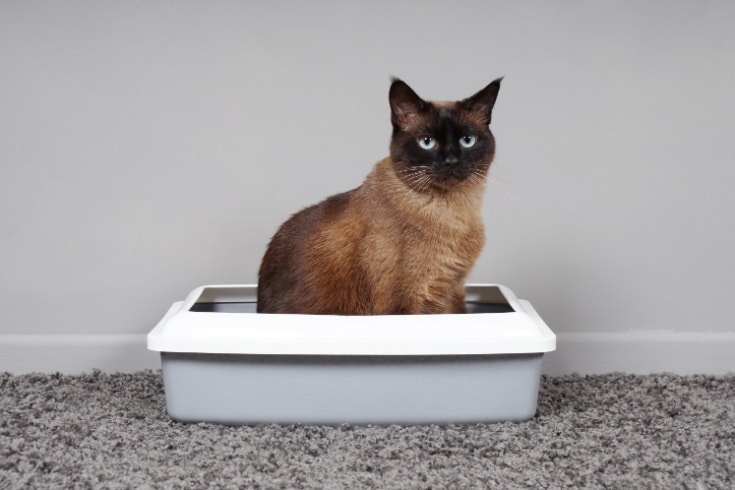
- Ensure you have the right supplies
Setting up your first litter box is incredibly easy. All the supplies that you really need are included in the name: litter & a box!
Choose a high-quality box that is longer than the length of your kitten from his nose to his tail. The box should have enough space for your kitty to turn around in. Try out both a covered & an uncovered box & see which option your cat prefers.
You’ll also need a bag of fine, clumping, unscented litter. You should also get a scooper to clean out the litter & an enzymatic cleaner to eliminate odors in case your kitty messes up a couple of times.
- Choose the right spot
The location of the litter box can make or break the litter training process. Most cats prefer if you keep it in a quieter, more secluded area of your home so that they are comfortable enough to relieve themselves in the tray.
However, some cats prefer to be in the thick of all the action all the time. So, look at where your kitty usually goes to the bathroom & keep the litter box there.
- Add enough litter
The litter tray should have a 2-inch deep layer of litter so that there is enough to absorb all the messes of the day & your cat won’t get his paws wet. Don’t skimp on the litter!
- Allow your cat to explore the litter box
Let your cat sniff around & step into the box of his own accord first. The tray can seem pretty big to a small cat, so you want to ensure he doesn’t feel intimidated by this new addition to the house furniture!
- Place your cat in the box several times a day
Once your cat is comfortable with seeing the box in their living space, you can start picking up your cat & placing it in the box yourself. Try to do it whenever you notice your kitty is about to relieve himself.
Once you notice the signs, such as sniffing the ground, digging in the carpet or a blanket, or squatting, immediately put your cat up & place him in the litter box.
- Reward, Reward, Reward!
If your cat does go in the tray, you should reward them with verbal praise & yummy treats (in moderation!). Not every cat enjoys being pet, but if you have a cuddly kitty, you can also give them a few pats for a job well done.
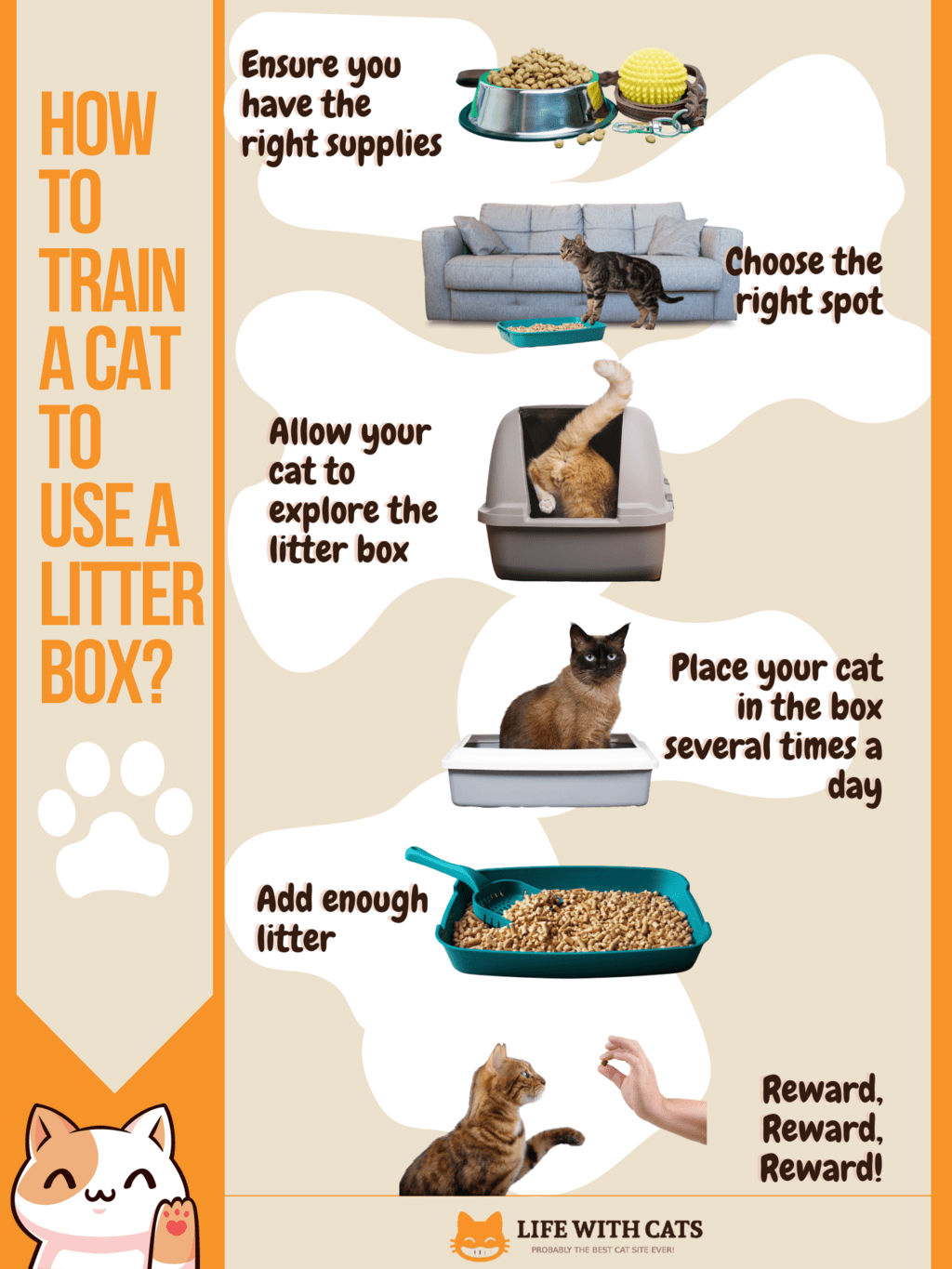
How Can I Litter Train a Kitten?
- Be Patient
Little kittens may take a little longer to learn new things so they might make a couple more mistakes along the way. The most important thing to remember as a pet parent is to stay calm & never lose your temper.
Your kitty is trying their hardest & they may make a few mistakes, but never yell at them or rub their noses in the mess. This will only confuse them further & create a negative association with the litter tray.
- Introduce the litter box soon
Don’t delay introducing the litter box to your kitten. As soon as you bring your cat into your home, make sure you set out a litter tray. While you don’t need to place your kitten in the box just yet, it’s a good opportunity for your kitten to explore the litter & sniff around.
- Recognize Cues
Recognize cues for when your kitty is about to go to the bathroom. This includes sniffing, meowing, pawing, sudden bursts of energy, and digging at the ground. As soon as you see these behaviors, put your kitten in the box immediately.
Plus, kittens tend to go to the bathroom as soon as they eat. So, put your cat in the litter tray right after mealtime just to be safe, to build that association between the litter box & going to the bathroom.
- Don’t be Discouraged if They Start Playing
A common question that kitten parents have is why their cat is playing in the litter. More often than not, this is just due to a case of a really bored kitty! Try adding a few enriching toys to your kitty’s life to bust boredom.
They could also be trying to cool themselves in the really warm months.
However, there is a possibility that your kitten is playing in the litter due to an underlying medical condition, such as a skin rash. If this problem persists, you should take your kitty to the vet to rule out any medical conditions.
- Choose the Right Litter
For a young kitten, I would always recommend an unscented litter because the scented litter can irritate your baby cat’s sinuses, which will only make the litter training process harder.
How to Train an Older Cat To Use a Litter Box?
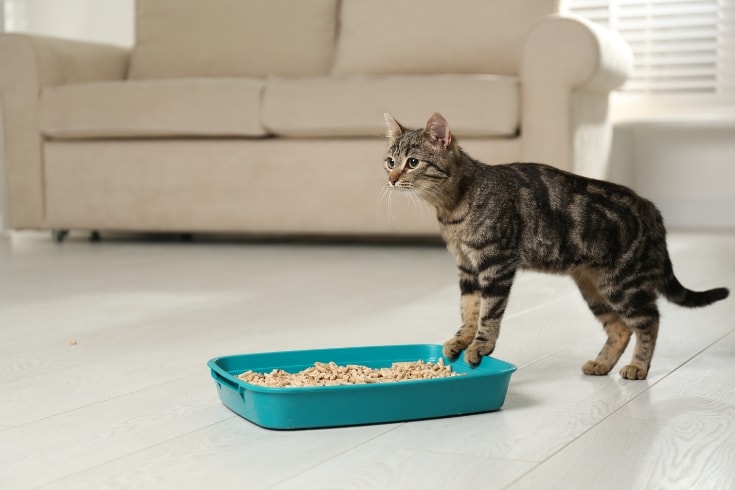
You can definitely train a senior cat to use a litter box, although it may take a bit more time & effort.
- Choose a Quiet Spot
Older cats typically prefer a quiet, secluded spot for their litter box to reduce stimulation while they are relieving themselves.
- Make the Box Familiar
Senior cats need some sort of familiarity with new obstacles. So, place a couple of your cat’s favorite toys or blankets near the box to make the area much more inviting & relaxing.
- Choose a Tray With Short Walls
Older cats tend to have joint problems, pain, and mobility issues. This can make stepping over a tall tray wall impossible for some kitties.
So, consider buying a tray with at least 1 really short wall that is easy for your cat to walk over. While it may lead to litter spraying & more messes to clean, your cat is more likely to use the tray if it is accessible.
- Buy a Ramp
If your cat really can’t lift their paws at all, you should consider buying a small ramp that leads them into the tray. This ensures that the box is accessible for even the most impaired cat.
How Can I Retrain a Cat to Use the Litter Box?
Sometimes after a move, a traumatic event, or a period of stress, your cat may stop using the litter box. However, retraining your kitty to use their litter box is totally possible. Often, since the foundation of litter training is already there, it’s only a matter of accessing that information again!
- Keep the Box Clean
Cats, especially stressed-out ones, dislike going to the bathroom in a messy tray. So, keep that litter box clean & make sure there’s enough litter to absorb the messes.
- Keep the Litter the Same
Some cats will stop using the tray if you abruptly change their litter. So, change the litter over a period of a week or so by slowly mixing some of the new litter in.
- Clean With an Enzymatic Cleaner
If your cat has started going to the bathroom behind the sofa or in another corner of your house, don’t just clean their messes with a regular detergent. Use an enzymatic cleaner to eliminate any lingering odors, so your cat won’t smell their urine & pee in that area again.
How Should I Clean the Litter Box?
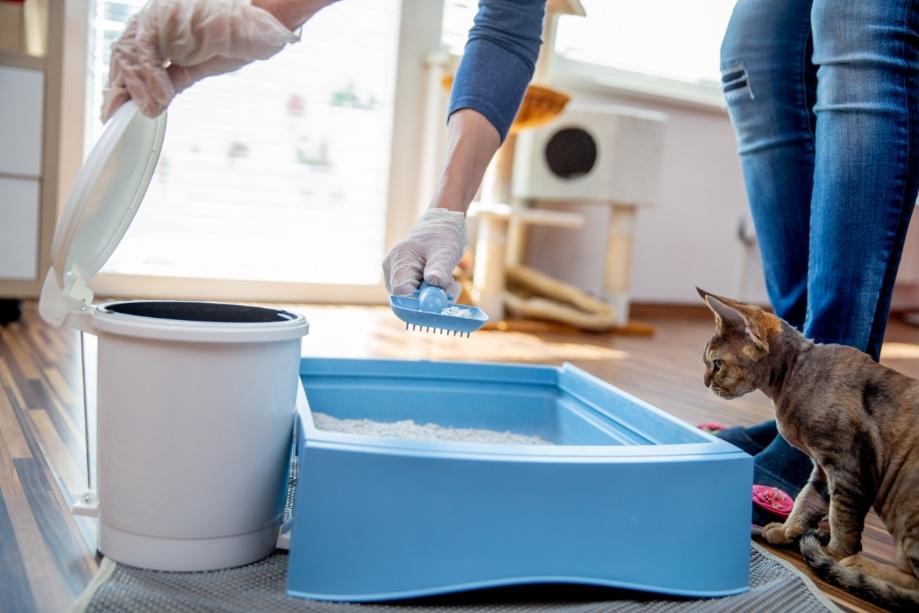
Cleaning your cat’s litter box is important in maintaining your cat’s health. Here are some tips to keep that litter box spick and span:
- Remove Messes Daily
Using your scooper, you should remove any urine and poop from the box at least once a day. This will reduce odors & increase the likelihood that your cat will actually use the tray, as kitties typically will only go in a clean litter box.
Place the clumps of used litter into a sealed bag & throw it away where your cat can’t get it. Then, rinse off the scooper with warm water & soap.
- Clean the Area Around the Box
You must have noticed that the top of a closed litter box & the area around the box can get really dirty from your cat tracking litter out. So, you can sweep up the area around the box using a small dustpan & clean surfaces with a pet-safe wipe daily.
- Intermittent Deep Cleans
Once a week, you should empty all the litter in the box & clean the litter tray with pet-safe soap & warm water. Then, fill up the tray with fresh litter again.
How often should I clean my cat’s litter box while litter box training?
While training, you definitely need to scoop out any clumps at least once or twice a day. A cat is more likely to relieve himself in a clean tray than a dirty one. You should replace all the litter & clean the tray with soap & water every week.
What are Some Things to Consider with Litter Box Training?
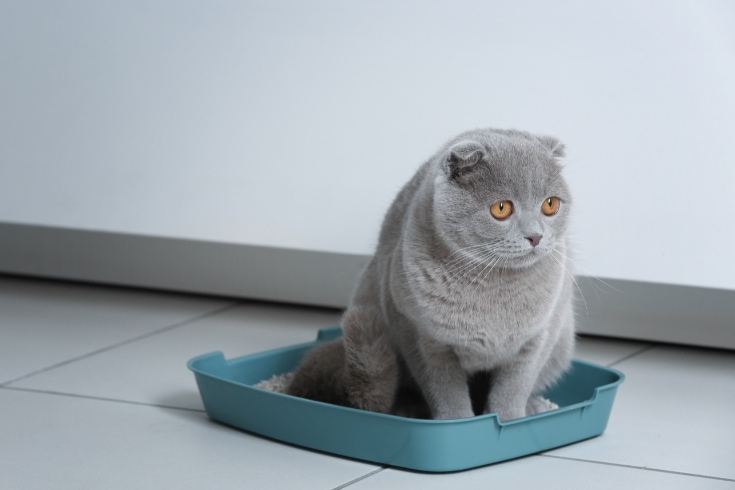
Here are some pawsome points to consider:
Is the cat spayed or neutered?
You’ll find that cat’s that haven’t been spayed or neutered will spray their urine in the house. This is done to mark their territory and it is normal behavior.
You can clean up their messes with an enzymatic cleaner to ensure that they won’t pee in the same area again.
Is the cat urinating against the wall or the sofa?
If you find small amounts of pee on the side of your walls or along the back of the sofa, this is an example of territorial peeing, or spraying.
This is behavioral & can be addressed by spaying/neutering your cat, cleaning with an enzymatic cleaner, and placing your cat in the box after meals to promote relieving themselves in the tray.
Does the cat use the litter box? Or does he still have accidents outside the litter box?
If you keep finding accidents outside of the litter tray, it may be because the tray is inaccessible to the cat because the walls are too high, the litter/tray is not preferred, the location is not preferred, or the cat is under a lot of stress.
Rule out these factors by switching out the litter, tray style, and location.
Is the cat stressed?
A stressed-out cat will find it really hard to use a litter box. They may have accidents out of the tray due to stress as well.
Do we need to retrain the cats?
Sometimes, after a move, a change in litter, tray, or placement, the cats will seemingly “forget” their litter training & will relieve themselves outside the litter box. They haven’t actually forgotten, but they are no longer used to this new litter setup.
So, you may need to make changes slowly, like moving the litter box foot-by-foot or slowly mixing in the new litter.
What are some of the issues with litter boxes?
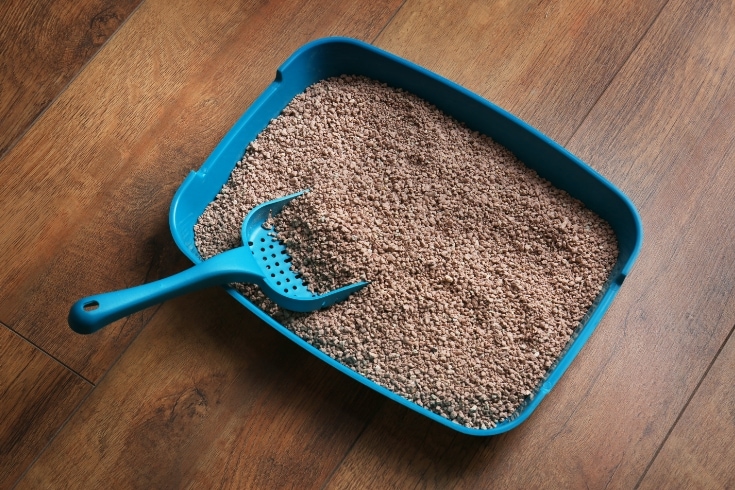
The issues with litter boxes are:
- Litter-Box Management Problems
If you don’t clean out the messes made in the litter box every day, this can make your cat uncomfortable and less likely to use the box.
- Surface Preference
Sometimes a cat just prefers to go on the soft carpet or blankets. This can be really frustrating because it leads to messes all around the house.
- Litter Preference
Since cats have such keen senses of smell, they will often have a really strong aversion to scented litter. Also, some cats dislike the crystal litter because it crackles slightly when it gets wet, which can be a little scary for some cats.
- Location Preference
Maybe your cat just doesn’t like the location you’ve picked out for the litter box. Consider experimenting with placing the tray on different floors & corners of your house.
- Inability to Use the Litter Box
Your kitty might be unable to use their litter box for a variety of reasons. Older cats & small kittens may not be able to enter a tray with really high walls. The box may also be too small for them to comfortably turn around in.
- Negative Litter-Box Association
This is often seen in rescue cats or cats with trauma. If they have previously been yelled at or hit during litter training, they may have developed a negative association with the litter box. If they have been stressed out while using the litter box, this can also cause a negative association.
- Household Stress
A stressed-out cat is less likely to efficiently use the litter box.
- Multi-Cat Household Conflict
If you have more than one cat, you might find that one kitty has totally taken over the litter box & is not allowing the other cats to use it.
How to prevent litter box problems?
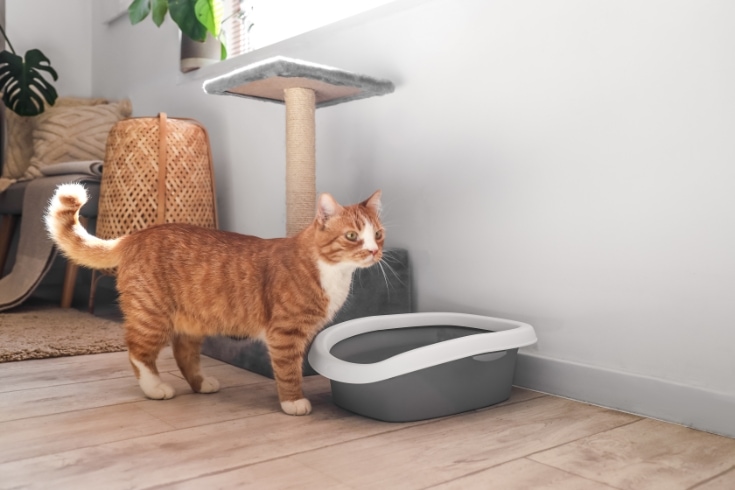
- Pick the right litter box location
Try to notice where your kitty frequently relieves himself. Then, place the litter box in that area. This is an area that your cat is already comfortable going to the bathroom in, which makes it easier to transition to a box.
- Select your litter carefully
Always try to go for a clumping, fine, unscented litter. Avoid crystal litter; although they can cause less dust, they crackle slightly when they get wet, which can be irritating to your cat. Try not to switch litter too much.
- Make the litter box accessible
Ensure that your cat can actually enter the tray. Make sure that there are low walls & a ramp if your cat has mobility issues.
- Have one box per cat, plus one
If you have multiple cats in your house, you will need to buy multiple litter boxes. If you have 3 cats in your house, buy 4 trays. If you have 4 cats, buy 5 trays. Always make sure there is an extra litter box in case one of your cats dominates or dirties a box.
- Give your cat attention
Make sure to give your cat tons of playtime, attention, and snuggles to help them relieve stress. This will make them more likely to use the litter box.
How to solve litter box problems?
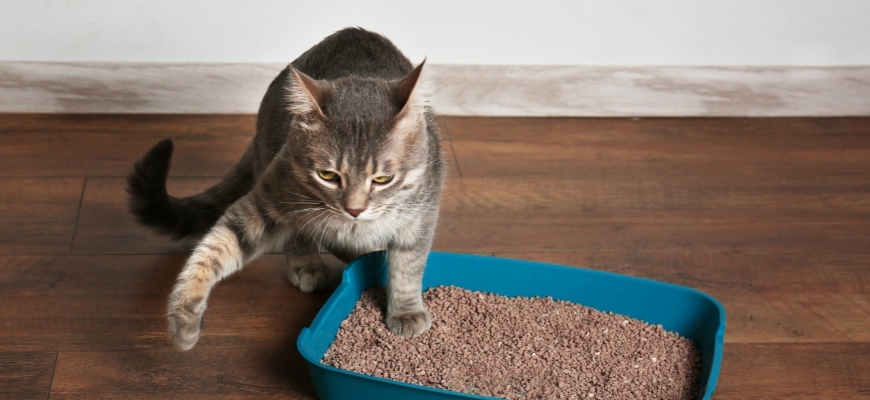
- Rule out illness
Sometimes, a refusal to go in the box or digging in the litter may actually be a sign of an underlying illness. If you feel like your cat isn’t stressed out, get them checked out at a vet’s office to rule out any possibility of illness.
- Don’t punish your cat
Never punish your cat for having an accident. This can cause a negative association to form with litter training, which will only set your progress back by a few weeks, months, or even years.
- Do a test
If no matter what you do, your cat just won’t use the tray, consider setting up multiple different boxes in different areas of the house, with different litter materials (including newspaper, crystal litter, fine litter, scented litter, sawdust, etc)., and different litter box designs.
See what your cat likes the most & try to incorporate it into their life.
- Clean properly
Clean the box thoroughly every day by removing all the clumps with the scoop. Cats will rarely relieve themselves in a used litter box.
- Confine
If you’ve found that your cat tends to have accidents in a certain small area of the house, such as the laundry room or the office, just shut the door to that room until your cat is more comfortable with going in the litter box.
- Other techniques
- If your cat thrives off of positive affirmations, give them tons of praise & treats when they relieve themself in the correct spot.
- Consider using air blasters & aluminum foil to deter your cat from going into areas where he often has accidents.
- Use an enzymatic cleaner to clean up accidents.
Cat Litter Box Training FAQs
Here are some frequently asked questions pet parents often have in regard to litter box training.
How long does it take to train a cat to use the litter box?
This is really dependent upon how quickly your cat can pick a new skill up. Some cats only need a few days, whereas some need a couple of months. In general, though, it should usually take around 3-4 weeks to train a kitten to use a litter box.
Is litter box training easy?
Litter box training can be as easy or as hard as you make it. Try to make it clear that the tray is the only place for your cat to relieve himself. Make sure that you stay patient if your cat makes a mistake & gently correct their behavior to limit issues down the line.
What is the fastest way to litter train a kitten?
The fastest way to litter train a kitten is to pick them up and place them in the litter box immediately after mealtime. This will build that positive association immediately.
How do you stimulate a kitten to poop?
Use unscented, alcohol-free baby wipes to rub your cat’s anus in a circular after a meal. This feels just like their mom licking their behind after a meal to stimulate pooping, which can help. If your cat is really constipated, you can also use a pet-safe laxative, but consult your vet first.
Why is my kitten sleeping in the litter box?
If you notice your cat sleeping in the litter box, this could be a sign of illness. Take your cat to the vet to rule out kidney issues, urinary problems, or constipation.
Do I need a litter box on every floor?
It’s preferred to have 1 litter tray for every floor of your house. This makes it more likely for your cat to actually use the boxes.
Do cats automatically use the litter box?
Cats have an instinctive urge to relieve themselves in the sand, which makes litter training super easy. In fact, some kittens will automatically start using the litter box without you even needing to place them in there.
When is it too late to litter train a cat?
It is never too late to litter train a cat. Since they innately prefer to pee & poop in dirt or sand, they will pick up on litter training pretty quickly. Older cats may take a little longer, but any cat can definitely learn how to use a litter box.
Conclusion
While litter training may be a confusing process for you and your kitten, we’ve tried to simplify it by providing everything you’ll need to get started, how to go about the training, and some ways to prevent issues down the line.
If you found this article informative, please share it with other pet parents. Thanks for reading!